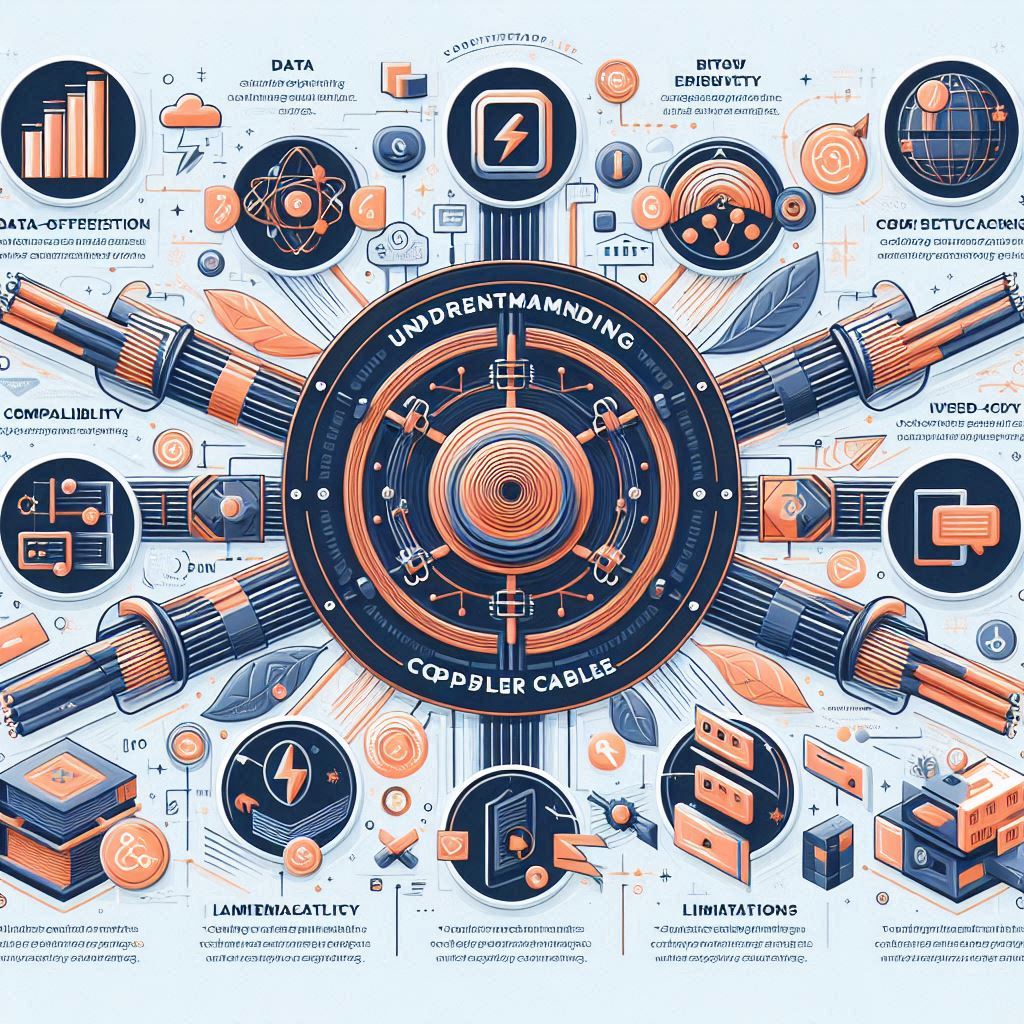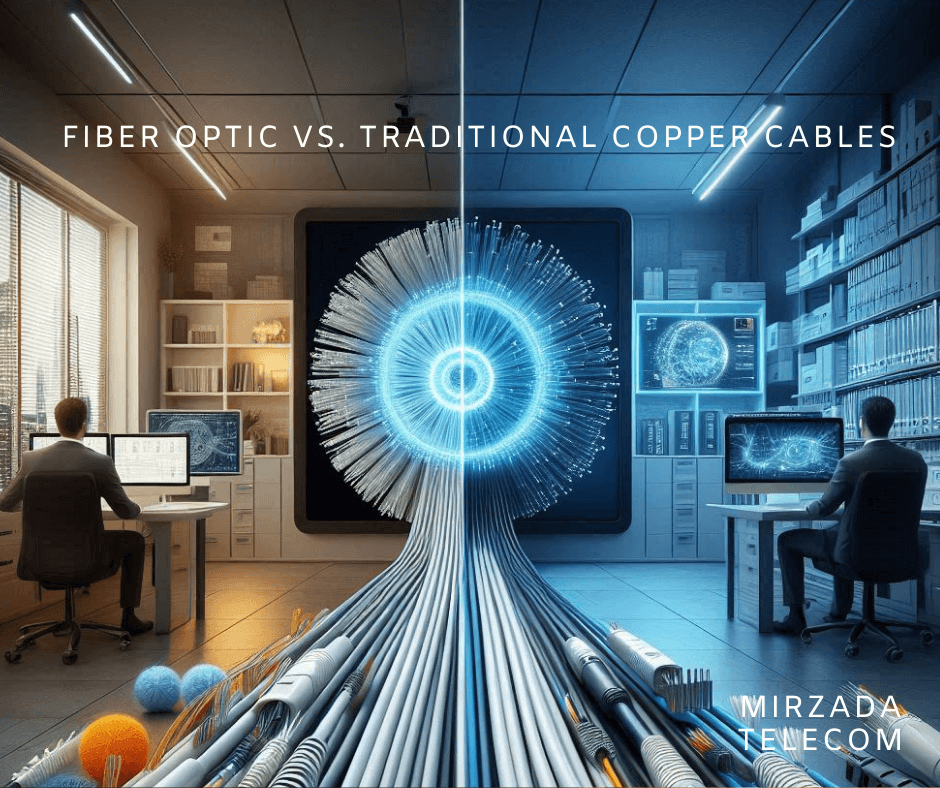Welcome! Today, we’re diving into a crucial topic for any business looking to enhance its network infrastructure—Fiber Optic vs. Traditional Copper Cables. Understanding the differences can help you make an informed decision about the best cabling solution for your needs.
In Mirzada Telecom, We are excited to guide you through a comparison of fiber optic cables and traditional copper cables. By the end of this discussion, you’ll have the insights you need to make an informed decision for your network setup.
Understanding Fiber Optic Cables

Let’s start with fiber optic cables. These cables transmit data using light signals, allowing for high-speed communication over long distances. They are essential for modern networks, especially as data demands increase.
Fiber optic cables are not just faster; they also support larger bandwidth, making them ideal for businesses that rely on high-volume data transmission. Their ability to maintain signal quality over long distances means fewer interruptions and better reliability, which are critical in today’s fast-paced environment.
Role of Fiber Optic Cables:
In addition to speed and reliability, fiber optic cables play a significant role in enhancing security. Because they transmit data via light rather than electrical signals, they are less susceptible to tapping and interference. This makes them an excellent choice for organizations handling sensitive information.
Understanding Traditional Copper Cables

Now, let’s discuss traditional copper cables. These cables have been the backbone of network infrastructure for decades. They transmit data using electrical signals and are often called “traditional” because they’ve been widely used since the early days of telecommunications.
Despite the rise of fiber optics, copper cables remain relevant due to their compatibility with existing systems and their lower installation costs. They are still suitable for certain applications, particularly where speed and distance requirements are minimal.
Role of Traditional Copper Cables
Copper cables are crucial for local area networks (LANs) and Power over Ethernet (PoE) applications, where they can transmit data and power simultaneously. However, they do have limitations in terms of distance and speed, making them less ideal for modern, high-demand networks.
Why Fiber Optics is Best for Today
In today’s digital landscape, businesses face ever-increasing data demands. Fiber optics not only meet these demands but exceed them, offering enhanced speed and reliability.
Key Benefits of Fiber Optic Cables:
- Speed and Bandwidth: Capable of transmitting data at rates exceeding 10 Gbps.
- Long Distance: Can transmit over vast distances without signal loss.
- Interference Resistance: Immune to electromagnetic interference (EMI).
- Durability: More resistant to environmental factors.
- Enhanced Security: Harder to tap without detection.
Advantages of Fiber Optics:
- Future-Proofing: With data consumption continuing to grow, investing in fiber optics ensures your infrastructure remains relevant.
- Higher Performance: The ability to support significant data traffic positions fiber optics as the preferred solution for modern businesses.
Disadvantages of Fiber Optic Cables
While fiber optic cables offer numerous benefits, they also come with a few drawbacks that businesses should consider.
- Higher Initial Cost: Installation can be more expensive than copper cables.
- Complex Installation: Requires specialized skills and equipment.
Is Traditional Copper Cables Best for Today?
Now, let’s compare traditional copper cables with fiber optics to see which option may be better for your needs Comparing with Fiber Optics, For businesses handling large amounts of data or sensitive information, fiber optics may offer significant advantages that justify the higher initial investment. While copper cables have their place, it’s important to weigh their advantages and Disadvantages against the benefits of fiber optics.
advantages of Traditional Copper Cables:
- Cost-Effective: Lower initial installation costs can make them appealing for budget-conscious businesses.
- Power Delivery: They can transmit both data and electrical power, useful for devices that require PoE.
- Compatibility: Widely compatible with existing infrastructure, making upgrades easier for some organizations.
Key Disadvantages of Traditional Copper Cables:
- Cost: While cheaper to install, they may not provide long-term value.
- Limited Distance and Speed: Best suited for shorter distances.
- Interference Issues: Susceptible to EMI, affecting signal quality.
- Power Limitations: While they can carry power, this can lead to increased heat and potential degradation.
Making the Right Choice: Fiber vs. Copper Cables
It seems like both options have their advantages and disadvantages. How do I choose the best one for my business? That’s an important question! The right choice depends on your specific needs:
- Choose Fiber Optic: If your business requires high-speed, long-distance communication with minimal interference, fiber optic cables are the better choice.
- Consider Copper: If you need a cost-effective solution for short-distance applications where power delivery is essential, traditional copper cables may suit you better.
Which One, Fiber vs. Copper Cables Is Best ?
Ultimately, if your business prioritizes high-speed data transmission, long distances, and reliability, fiber optic cables are the best choice. They outperform copper cables in speed and performance, making them ideal for modern networking needs. On the other hand, if you’re looking for a budget-friendly option for short distances, copper cables may suffice. However, for most businesses aiming for long-term growth, fiber optics is the way to go.
Conclusion
Choosing the right cabling is crucial for efficient and reliable data transmission. At Mirzada Telecom, we are committed to providing the best fiber optic network setups for businesses, leveraging our expertise to meet your needs.
when comparing fiber optics vs. traditional copper cables, fiber optics emerge as the best choice for businesses needing high-speed, reliable data transmission over long distances. While copper cables may be cost-effective for short distances, they don’t match the performance of fiber optics. For a robust and future-proof network, fiber optics is the ideal option.
FAQs
What are the main advantages of fiber optic cables over copper cables?
Fiber optic cables offer higher speeds, greater bandwidth, longer transmission distances, immunity to EMI, and enhanced security.
Are fiber optic cables more expensive than copper cables?
Yes, they generally have a higher installation cost but provide superior performance and reliability.
Can fiber optic cables be used for Power over Ethernet (PoE) applications?
No, fiber optic cables cannot carry electrical power; copper cables are used for PoE.
How does Mirzada Telecom ensure the security of fiber optic networks when you chose within Fiber vs. Copper Cables?
We implement advanced encryption and monitoring techniques to protect data transmitted over our fiber optic networks.
